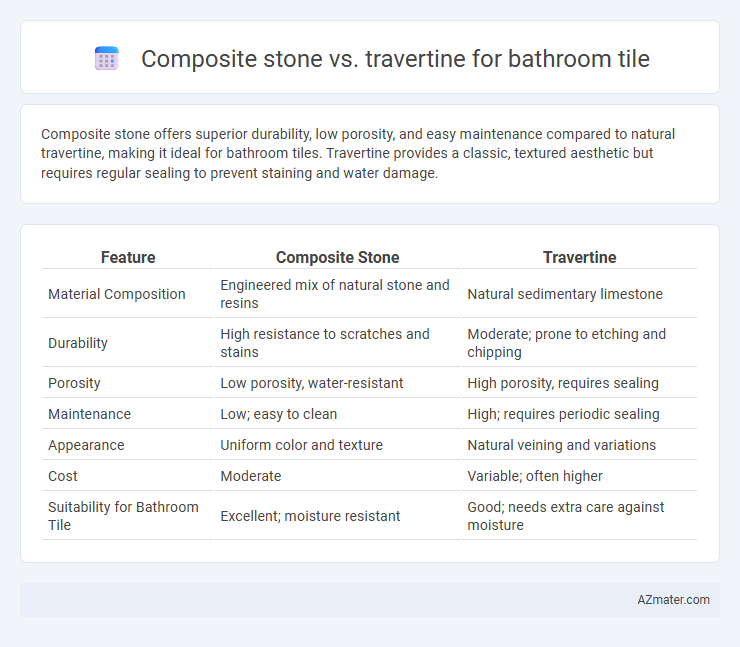Composite stone offers superior durability, low porosity, and easy maintenance compared to natural travertine, making it ideal for bathroom tiles. Travertine provides a classic, textured aesthetic but requires regular sealing to prevent staining and water damage.
Table of Comparison
| Feature | Composite Stone | Travertine |
|---|---|---|
| Material Composition | Engineered mix of natural stone and resins | Natural sedimentary limestone |
| Durability | High resistance to scratches and stains | Moderate; prone to etching and chipping |
| Porosity | Low porosity, water-resistant | High porosity, requires sealing |
| Maintenance | Low; easy to clean | High; requires periodic sealing |
| Appearance | Uniform color and texture | Natural veining and variations |
| Cost | Moderate | Variable; often higher |
| Suitability for Bathroom Tile | Excellent; moisture resistant | Good; needs extra care against moisture |
Introduction to Bathroom Tile Options
Composite stone offers durability, stain resistance, and easy maintenance, making it a popular choice for bathroom tiles. Travertine, a natural stone with distinctive veining and warm tones, provides a luxurious and timeless aesthetic but requires more care to prevent water damage and staining. Selecting between composite stone and travertine depends on balancing the need for practical performance with desired visual appeal in bathroom settings.
What is Composite Stone?
Composite stone, made from a blend of natural stone chips and resin binders, offers a durable and low-porosity alternative to natural travertine in bathroom tiles. Its non-porous nature resists water absorption and staining, making it ideal for high-moisture environments like bathrooms. Compared to travertine, composite stone requires less maintenance while providing a similar aesthetic with enhanced durability and uniformity.
What is Travertine?
Travertine is a natural limestone formed by mineral deposits from hot springs, characterized by its porous surface and warm, earthy tones. It is a popular choice for bathroom tiles due to its textured appearance and durability, though it requires sealing to prevent staining and water damage. In comparison, composite stone offers a non-porous, low-maintenance alternative with consistent patterns and enhanced resistance to moisture and wear.
Appearance and Design Versatility
Composite stone offers a uniform appearance with customizable colors and patterns, making it ideal for modern bathroom designs seeking consistency and sleek aesthetics. Travertine features natural veining and a textured surface that provides a classic, earthy look, enhancing bathrooms with rustic or traditional styles. The design versatility of composite stone surpasses travertine due to its adaptability in shape, size, and finish, allowing for more precise design execution.
Durability and Longevity
Composite stone offers superior durability and resistance to scratches, stains, and moisture compared to travertine, making it ideal for high-traffic bathroom areas. Travertine, a natural limestone, tends to be more porous and susceptible to etching and wear over time without regular sealing. Choosing composite stone ensures longer-lasting performance and less maintenance in bathroom tile applications.
Maintenance and Cleaning Needs
Composite stone bathroom tiles require minimal maintenance due to their non-porous surface, resisting stains, mold, and mildew more effectively than travertine. Travertine tiles are porous natural stones that demand regular sealing to prevent water absorption and staining, increasing cleaning efforts. Routine cleaning with pH-neutral cleaners is essential for travertine, while composite stone tolerates a wider range of cleaning agents, simplifying upkeep.
Water and Stain Resistance
Composite stone offers superior water and stain resistance for bathroom tiles compared to travertine, making it an ideal material in wet environments. Travertine, a natural porous stone, requires frequent sealing to prevent water absorption and staining, which can lead to discoloration and surface damage over time. The non-porous nature of composite stone ensures easier maintenance and lasting durability against moisture and common bathroom stains.
Installation Process and Cost
Composite stone bathroom tiles offer a streamlined installation process due to their uniform size and lightweight nature, significantly reducing labor time and costs compared to natural travertine tiles. Travertine requires careful sealing and precise cutting because of its porous and uneven surface, resulting in higher installation complexity and increased expenses. The overall cost of composite stone installations is typically lower, making it a budget-friendly choice without sacrificing durability or aesthetic appeal.
Environmental Impact and Sustainability
Composite stone bathroom tiles offer a lower environmental impact due to their use of recycled materials and less intensive manufacturing processes compared to travertine, which involves quarrying natural stone that can lead to habitat disruption and higher carbon emissions. Travertine is a natural sedimentary rock that requires significant energy consumption during extraction and processing, whereas composite stone tiles often incorporate eco-friendly resins and sustainable production techniques. Choosing composite stone supports sustainable building practices by minimizing resource depletion and reducing landfill waste.
Which Tile is Best for Your Bathroom?
Composite stone offers superior durability and resistance to moisture, making it an excellent choice for bathroom tiles where water exposure is constant. Travertine provides a natural, elegant look with unique textures and warm tones but requires regular sealing to prevent staining and water damage. For low-maintenance and long-lasting bathroom flooring, composite stone generally outperforms travertine in both functionality and longevity.

Infographic: Composite stone vs Travertine for Bathroom Tile
 azmater.com
azmater.com